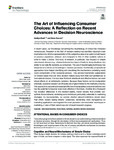The Art of Influencing Consumer Choices: A Reflection on Recent Advances in Decision Neuroscience
| dc.contributor.author | Bault, Nadège | |
| dc.contributor.author | Rusconi, E | |
| dc.date.accessioned | 2020-01-21T15:48:52Z | |
| dc.date.available | 2020-01-21T15:48:52Z | |
| dc.date.issued | 2020-01-21 | |
| dc.identifier.issn | 1664-1078 | |
| dc.identifier.issn | 1664-1078 | |
| dc.identifier.other | ARTN 3009 | |
| dc.identifier.uri | http://hdl.handle.net/10026.1/15331 | |
| dc.description.abstract |
In recent years, our knowledge concerning the neurobiology of choice has increased tremendously. Research in the field of decision-making has identified important brain mechanisms by which a representation of the subjective value of an option is built based on previous experience, retrieved and compared to that of other available options in order to make a choice. One body of research, in particular, has focused on simple value-based choices (e.g., choices between two types of fruits) to study situations very similar to our daily life decisions as consumers. The use of neuroimaging techniques has deepened and refined our knowledge of decision processes. Additionally, computational approaches have helped identifying and describing the mechanisms underlying newly found components of the decisional process. They provide mechanistic explanations for diverse biases that can drive decision makers away from their own preferences or from rational choices. It is now clear that both attentional and affective factors can exert robust effects on an individual’s decisions. Because these factors can be manipulated externally, academic research and theories are of great interest to the marketing industry. This approach is becoming increasingly effective in manipulating consumer behavior and has the potential to become even more effective in the future. Another line of research has revealed differences in the decision-making neural circuitry that underlie sub-optimal choice behavior, rendering some individuals particularly vulnerable to marketing strategies. As neuroscientists, we wonder whether relevant institutions should direct their efforts toward raising citizens’ awareness, demanding more transparency on marketing applications and regulate the most pervasive communication techniques in marketing, in view of their current use and of recent research progress. | |
| dc.format.extent | 3009- | |
| dc.format.medium | Electronic-eCollection | |
| dc.language | eng | |
| dc.language.iso | en | |
| dc.publisher | Frontiers Media SA | |
| dc.subject | value-based decisions | |
| dc.subject | choice biases | |
| dc.subject | marketing | |
| dc.subject | regulation | |
| dc.subject | decision neuroscience | |
| dc.title | The Art of Influencing Consumer Choices: A Reflection on Recent Advances in Decision Neuroscience | |
| dc.type | journal-article | |
| dc.type | Journal Article | |
| plymouth.author-url | https://www.webofscience.com/api/gateway?GWVersion=2&SrcApp=PARTNER_APP&SrcAuth=LinksAMR&KeyUT=WOS:000510934200001&DestLinkType=FullRecord&DestApp=ALL_WOS&UsrCustomerID=11bb513d99f797142bcfeffcc58ea008 | |
| plymouth.volume | 10 | |
| plymouth.publication-status | Published online | |
| plymouth.journal | Frontiers in Psychology | |
| dc.identifier.doi | 10.3389/fpsyg.2019.03009 | |
| plymouth.organisational-group | /Plymouth | |
| plymouth.organisational-group | /Plymouth/Faculty of Health | |
| plymouth.organisational-group | /Plymouth/Faculty of Health/School of Psychology | |
| plymouth.organisational-group | /Plymouth/REF 2021 Researchers by UoA | |
| plymouth.organisational-group | /Plymouth/REF 2021 Researchers by UoA/UoA04 Psychology, Psychiatry and Neuroscience | |
| plymouth.organisational-group | /Plymouth/Users by role | |
| plymouth.organisational-group | /Plymouth/Users by role/Academics | |
| dc.publisher.place | Switzerland | |
| dcterms.dateAccepted | 2019-12-19 | |
| dc.rights.embargodate | 2020-1-23 | |
| dc.identifier.eissn | 1664-1078 | |
| dc.rights.embargoperiod | Not known | |
| rioxxterms.versionofrecord | 10.3389/fpsyg.2019.03009 | |
| rioxxterms.licenseref.uri | http://www.rioxx.net/licenses/all-rights-reserved | |
| rioxxterms.licenseref.startdate | 2020-01-21 | |
| rioxxterms.type | Journal Article/Review |


